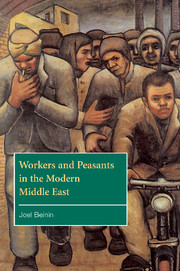Book contents
- Frontmatter
- Contents
- List of tables
- Acknowledgments
- Glossary
- List of acronyms and abbreviations
- Map 1: The Ottoman Empire, 1699–1914
- Map 2: Egypt and Bilad al-Sham
- Map 3: The Middle East in the twentieth century
- Introduction
- 1 The world capitalist market, provincial regimes, and local producers, 1750–1839
- 2 Ottoman reform and European imperialism, 1839–1907
- 3 The rise of mass politics, 1908–1939
- 4 Fikri al-Khuli's journey to al-Mahalla al-Kubra
- 5 Populist nationalism, state-led development, and authoritarian regimes, 1939–1973
- 6 Post-populist reformation of the working class and peasantry
- Notes
- References
- Index
2 - Ottoman reform and European imperialism, 1839–1907
Published online by Cambridge University Press: 03 February 2010
- Frontmatter
- Contents
- List of tables
- Acknowledgments
- Glossary
- List of acronyms and abbreviations
- Map 1: The Ottoman Empire, 1699–1914
- Map 2: Egypt and Bilad al-Sham
- Map 3: The Middle East in the twentieth century
- Introduction
- 1 The world capitalist market, provincial regimes, and local producers, 1750–1839
- 2 Ottoman reform and European imperialism, 1839–1907
- 3 The rise of mass politics, 1908–1939
- 4 Fikri al-Khuli's journey to al-Mahalla al-Kubra
- 5 Populist nationalism, state-led development, and authoritarian regimes, 1939–1973
- 6 Post-populist reformation of the working class and peasantry
- Notes
- References
- Index
Summary
The mid-nineteenth-century legal, administrative, and fiscal reforms known as the Tanzimat are widely considered the beginning of the modern period, inspired by the ideas of secularism and progress promoted by the French revolution (Lewis 1961; Davison 1963; Berkes 1964; Shaw & Shaw 1976–77). The salient politico-legal markers of the Tanzimat era are the 1839 Gülhane Edict (Hatt-ι Şerif), the 1856 Reform Decree (Islahat Fermanι), and the 1876 constitution, which was abrogated in 1878 by Sultan Abdühamid II (1876–1909). The Tanzimat decrees abolished tax farming, introduced military conscription, and promised legal equality for all the sultan's subjects regardless of their religious community. They also marked the adoption of a European-influenced discourse of “reform” that justified practices elites hoped would strengthen the Ottoman state.
The Tanzimat decrees discursively authorized the central categories of a modern political economy: “citizens,” the constituent elements of nation-states; and “the economy” as an abstract entity distinct from the state and subject to its own rules. The Gülhane Edict's promise of “perfect security to all the populations of our Empire in their lives, their honor, and their properties” resonates with phrases of John Locke and Thomas Jefferson, though its origin as a royal decree is in tension with the spirit of the words (Hurewitz 1975: I, 270–71).
- Type
- Chapter
- Information
- Workers and Peasants in the Modern Middle East , pp. 44 - 70Publisher: Cambridge University PressPrint publication year: 2001
- 1
- Cited by

